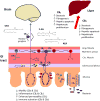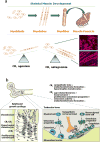Endocannabinoid signaling at the periphery: 50 years after THC
- PMID: 25796370
- PMCID: PMC4420685
- DOI: 10.1016/j.tips.2015.02.008
Endocannabinoid signaling at the periphery: 50 years after THC
Abstract
In 1964, the psychoactive ingredient of Cannabis sativa, Δ(9)-tetrahydrocannabinol (THC), was isolated. Nearly 30 years later the endogenous counterparts of THC, collectively termed endocannabinoids (eCBs), were discovered: N-arachidonoylethanolamine (anandamide) (AEA) in 1992 and 2-arachidonoylglycerol (2-AG) in 1995. Since then, considerable research has shed light on the impact of eCBs on human health and disease, identifying an ensemble of proteins that bind, synthesize, and degrade them and that together form the eCB system (ECS). eCBs control basic biological processes including cell choice between survival and death and progenitor/stem cell proliferation and differentiation. Unsurprisingly, in the past two decades eCBs have been recognized as key mediators of several aspects of human pathophysiology and thus have emerged to be among the most widespread and versatile signaling molecules ever discovered. Here some of the pioneers of this research field review the state of the art of critical eCB functions in peripheral organs. Our community effort is aimed at establishing consensus views on the relevance of the peripheral ECS for human health and disease pathogenesis, as well as highlighting emerging challenges and therapeutic hopes.
Keywords: bone; cardiovascular system; female and male reproductive system; gastrointestinal tract; immune system; liver; localization; muscle; signaling pathways; skin.
Copyright © 2015 Elsevier Ltd. All rights reserved.
Figures






Similar articles
-
Endocannabinoid signaling in female reproductive events: a potential therapeutic target?Expert Opin Ther Targets. 2015;19(11):1423-7. doi: 10.1517/14728222.2015.1062878. Epub 2015 Jun 30. Expert Opin Ther Targets. 2015. PMID: 26126134
-
Need for Methods to Investigate Endocannabinoid Signaling.Methods Mol Biol. 2023;2576:1-8. doi: 10.1007/978-1-0716-2728-0_1. Methods Mol Biol. 2023. PMID: 36152173
-
The Relationship Between Circulating Endogenous Cannabinoids and the Effects of Smoked Cannabis.Cannabis Cannabinoid Res. 2023 Dec;8(6):1069-1078. doi: 10.1089/can.2021.0185. Epub 2022 Apr 29. Cannabis Cannabinoid Res. 2023. PMID: 35486827 Free PMC article.
-
Cannabinoid receptor signaling in progenitor/stem cell proliferation and differentiation.Prog Lipid Res. 2013 Oct;52(4):633-50. doi: 10.1016/j.plipres.2013.05.004. Epub 2013 Sep 25. Prog Lipid Res. 2013. PMID: 24076098 Review.
-
Missing Pieces to the Endocannabinoid Puzzle.Trends Mol Med. 2020 Mar;26(3):263-272. doi: 10.1016/j.molmed.2019.11.002. Epub 2019 Dec 7. Trends Mol Med. 2020. PMID: 31822395 Review.
Cited by
-
Glycerophosphodiesterase 3 (GDE3) is a lysophosphatidylinositol-specific ectophospholipase C acting as an endocannabinoid signaling switch.J Biol Chem. 2020 Nov 13;295(46):15767-15781. doi: 10.1074/jbc.RA120.015278. Epub 2020 Sep 11. J Biol Chem. 2020. PMID: 32917725 Free PMC article.
-
Structure-Activity Relationship Studies of α-Ketoamides as Inhibitors of the Phospholipase A and Acyltransferase Enzyme Family.J Med Chem. 2020 Sep 10;63(17):9340-9359. doi: 10.1021/acs.jmedchem.0c00522. Epub 2020 Aug 13. J Med Chem. 2020. PMID: 32787138 Free PMC article.
-
The Interplay between the Immune and the Endocannabinoid Systems in Cancer.Cells. 2021 May 21;10(6):1282. doi: 10.3390/cells10061282. Cells. 2021. PMID: 34064197 Free PMC article. Review.
-
Leveraging allostery to improve G protein-coupled receptor (GPCR)-directed therapeutics: cannabinoid receptor 1 as discovery target.Expert Opin Drug Discov. 2016 Dec;11(12):1223-1237. doi: 10.1080/17460441.2016.1245289. Epub 2016 Oct 21. Expert Opin Drug Discov. 2016. PMID: 27712124 Free PMC article. Review.
-
G protein-coupled receptors in acquired epilepsy: Druggability and translatability.Prog Neurobiol. 2019 Dec;183:101682. doi: 10.1016/j.pneurobio.2019.101682. Epub 2019 Aug 24. Prog Neurobiol. 2019. PMID: 31454545 Free PMC article. Review.
References
-
- Gaoni Y, Mechoulam R. Isolation, structure and partial synthesis of an active constituent of hashish. J Amer Chem Soc. 1964;86:1646–1647.
-
- Howlett AC, Fleming RM. Cannabinoid inhibition of adenylate cyclase. Pharmacology of the response in neuroblastoma cell membranes. Mol Pharmacol. 1984;26:532–538. - PubMed
-
- Mechoulam R, et al. Enantiomeric cannabinoids: stereospecificity of psychotropic activity. Experientia. 1988;44:762–764. - PubMed
-
- Devane WA, et al. Determination and characterization of a cannabinoireceptor in rat brain. Mol Pharmacol. 1988;34:605–613. - PubMed
-
- Matsuda LA, et al. Structure of a cannabinoid receptor and functional expression of the cloned cDNA. Nature. 1990;346:561–564. - PubMed
Publication types
MeSH terms
Substances
Grants and funding
LinkOut - more resources
Full Text Sources
Other Literature Sources
Miscellaneous

